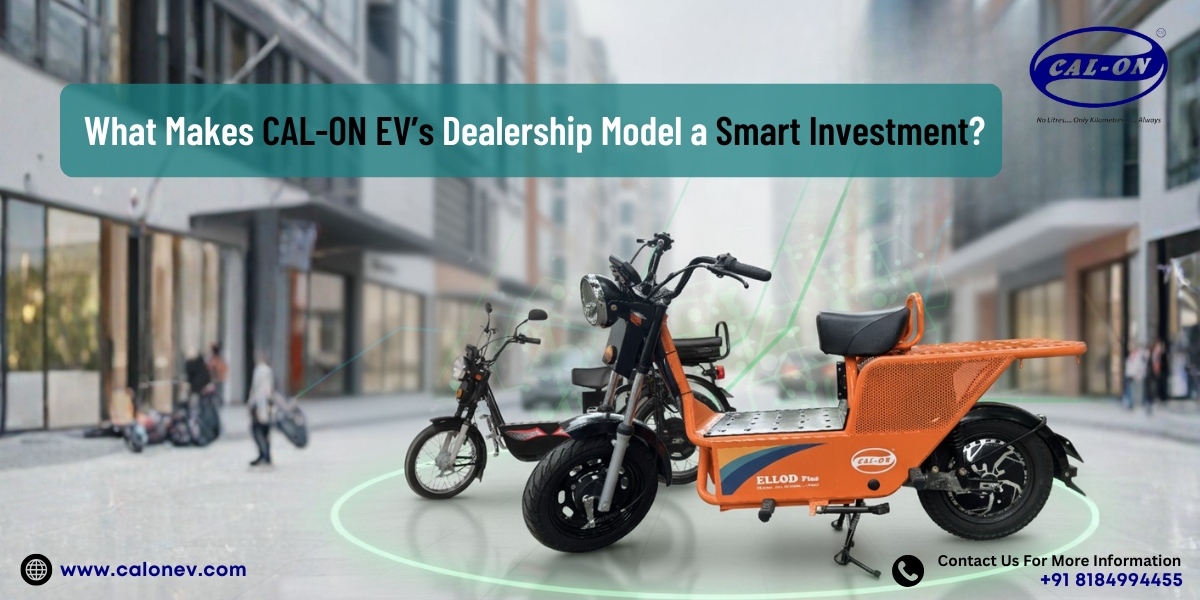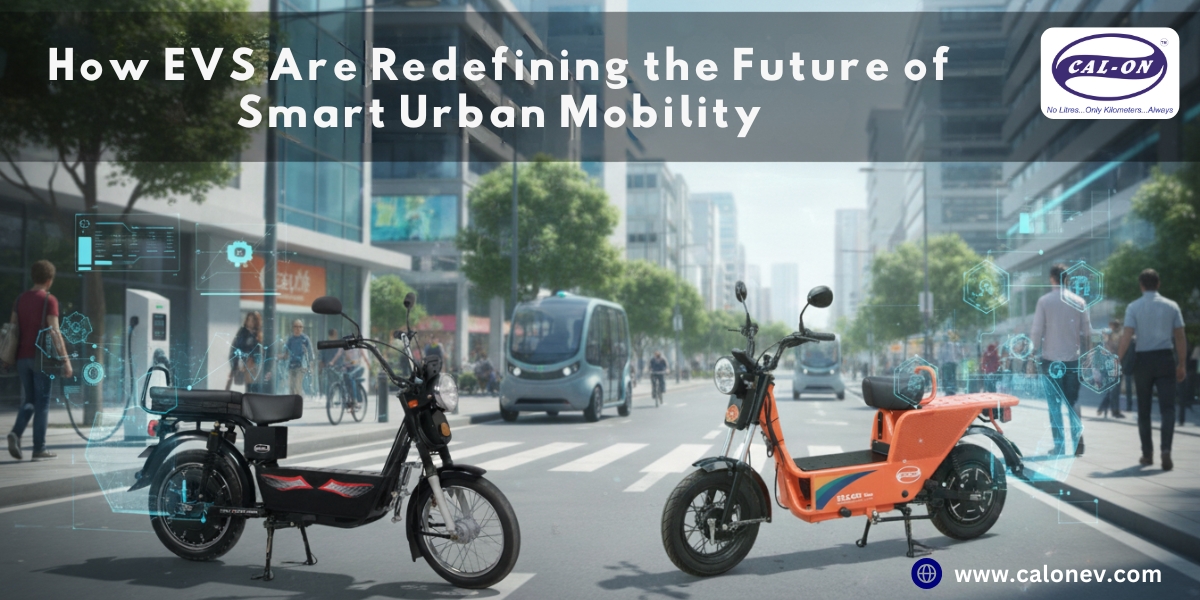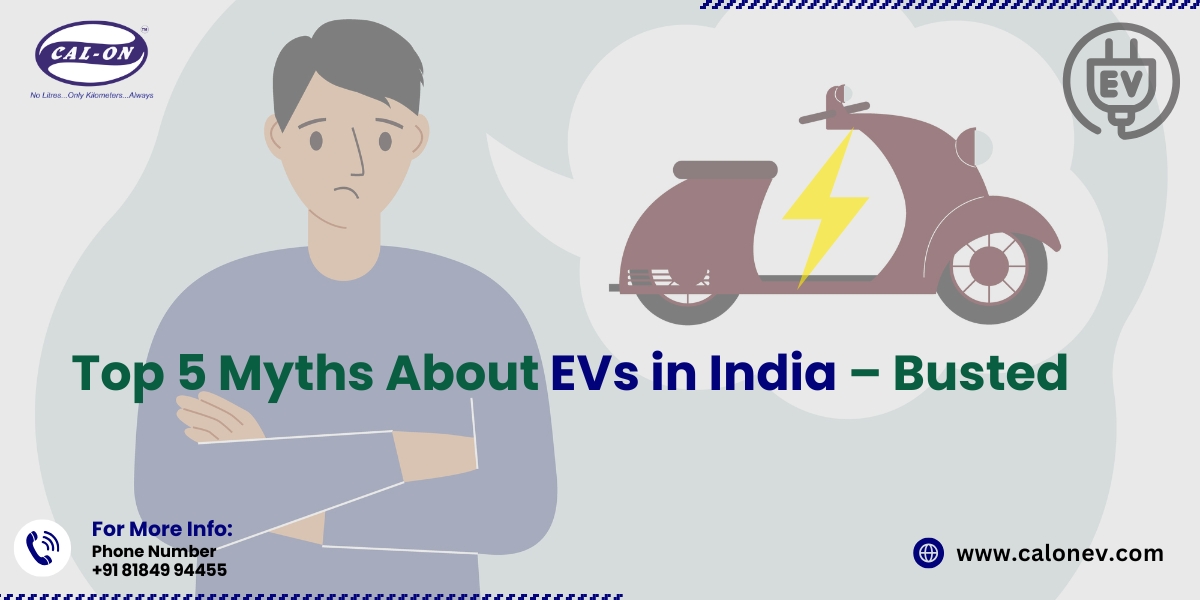The Transformative Connection Between EVs and Urban Mobility
The world’s cities are changing – and so is the way people move within them. As traffic congestion, rising fuel costs, and air pollution continue to challenge modern living. EVs and Urban Mobility have become the defining conversation for a sustainable, smarter future.
At CAL-ON EV, we see electric mobility not just as a trend but as the next great leap in Smart Urban Mobility with EVs – a revolution that combines technology, sustainability, and innovation to reshape how we travel.
From cleaner air to connected rides, Electric Vehicles in Urban Transportation are leading the charge toward sustainable urban transport. And as India’s cities expand and evolve into smarter ecosystems, EV adoption in cities will play a pivotal role in ensuring that growth remains both sustainable and inclusive.
This blog dives deep into how EVs and Urban Mobility are intertwined, how EV infrastructure development is transforming cities, and how CAL-ON EV is contributing to the green transportation revolution across India.
EVs and Urban Mobility: The New Backbone of Sustainable Cities
Urban mobility has always been at the heart of city life. But in recent years, the growing focus on sustainability and climate action has pushed cities to rethink how people commute. The answer lies in electric mobility solutions that make urban transportation cleaner, quieter, and smarter.
The Shift from Conventional to Smart Urban Mobility with EVs
Traditional vehicles powered by fossil fuels have long dominated city roads. However, their impact on air quality, energy consumption, and infrastructure is no longer sustainable. Enter Smart Urban Mobility with EVs, where every ride contributes to a cleaner environment and better city planning.
With the rise of Electric Vehicles in Urban Transportation, cities are now embracing eco-friendly city mobility – a concept that merges EV innovation and technology with efficient traffic management, intelligent charging, and integrated data systems.
The role of EVs in smart cities goes beyond transportation – they’re becoming an essential part of the smart city electric mobility ecosystem, driving innovation and sustainability hand in hand.
Why EVs Are the Future of Electric Mobility
1. The Growing EV Adoption in Cities
India is witnessing an unprecedented boom in EV adoption in cities. With over 1.6 million EVs registered as of 2024, urban centers like Delhi, Bangalore, and Hyderabad are leading the transition toward sustainable commuting.
The convenience of public EV charging networks, combined with government policies promoting EV infrastructure development, is making electric mobility more accessible than ever. For daily commuters and fleet operators alike, EVs represent the perfect blend of efficiency, economy, and eco-consciousness.
At CAL-ON EV, our electric two-wheelers – designed for city rides – align perfectly with this new urban rhythm. Compact, efficient, and powered by innovation, they represent the future of electric mobility built for Indian streets.
2. The Role of EVs in Smart Cities
Smart cities are built on three pillars: connectivity, efficiency, and sustainability. EVs and Urban Mobility support all three.
The role of EVs in smart cities includes reducing noise pollution, cutting down fuel dependency, and enabling connected mobility solutions that integrate seamlessly with public transport networks.
For example, in many urban regions, electric two-wheelers and buses are being linked to smart transportation systems that track energy consumption, optimize routes, and even manage traffic flow based on real-time data.
As CAL-ON EV continues to innovate, our vision is to help India’s cities build an eco-friendly city mobility network that prioritizes cleaner air, faster commutes, and smarter infrastructure.
3. Sustainable Urban Transport: Clean, Connected, and Cost-Efficient
Sustainable urban transport isn’t just about replacing petrol vehicles with EVs – it’s about redesigning entire mobility systems. By integrating electric vehicles in urban transportation, cities can cut their CO₂ emissions by up to 40% over the next decade.
EVs also consume 70% less energy per kilometer than conventional vehicles. That means better mileage, lower running costs, and huge environmental benefits.
This transition is powered by advances in EV innovation and technology – lighter batteries, faster charging, and longer range – making electric mobility solutions more practical for everyday life.
At CAL-ON EV, we’re proud to play our part by offering high-efficiency electric scooters that not only save money but also help cities achieve their green transportation revolution goals.
EV Infrastructure Development: Building the Foundation for Smart Urban Mobility with EVs
1. EV Charging Stations in Urban Areas
The growth of EVs and Urban Mobility depends heavily on EV charging stations in urban areas. Cities across India are witnessing the rapid expansion of public EV charging networks, ensuring that users can charge their vehicles conveniently – at home, at work, or on the go.
By 2030, India aims to install over 46,000 public charging points, making smart city electric mobility ecosystems truly accessible.
At CAL-ON EV, our models are designed to charge easily through household outlets, making EV adoption in cities seamless for individual and commercial users.
2. Government Policies for EV Adoption
Strong government policies for EV adoption are the driving force behind India’s electric revolution. Schemes like FAME II, Production Linked Incentive (PLI), and state-level subsidies encourage both manufacturers and consumers to invest in energy-efficient mobility.
These policies not only promote EV infrastructure development but also integrate electric vehicles and city planning by encouraging the creation of dedicated EV lanes, smart charging hubs, and clean energy corridors.
3. Connected Mobility Solutions: The Smart Edge of EV Technology
The future of EVs and Urban Mobility lies in connectivity. Connected mobility solutions use IoT (Internet of Things) and cloud-based systems to enhance EV innovation and technology – helping riders monitor battery health, optimize routes, and even find the nearest EV charging stations in urban areas.
These smart transportation systems make commuting smoother and smarter, enabling users to save time and energy. CAL-ON EV is committed to integrating these advancements to create a sustainable future of transportation that’s connected, intelligent, and user-centric.
Electric Vehicles and City Planning: Building Smart, Livable Spaces
1. Rethinking Urban Design
The integration of electric vehicles and city planning goes beyond roads. It’s about designing spaces that accommodate clean energy transport – wider charging hubs, shared e-mobility zones, and EV-friendly parking spaces.
By optimizing city layouts, local governments can support higher EV adoption in cities, making commutes shorter and infrastructure more resilient.
2. Reducing Pollution Through Electric Vehicles
Air quality has become one of the biggest urban challenges. Over 40% of city air pollution comes from vehicle emissions. The switch to sustainable urban transport through EVs can reduce urban pollution levels significantly.
According to NITI Aayog, widespread adoption of Electric Vehicles in Urban Transportation could save India 1 gigaton of CO₂ emissions by 2035. That’s the scale of the green transportation revolution already underway – and CAL-ON EV is proud to be a part of it.
3. EV Innovation and Technology Driving Change
Innovation is what makes Smart Urban Mobility with EVs possible. Breakthroughs in battery life, energy regeneration, and lightweight materials are redefining what’s achievable.
Modern electric mobility solutions now offer faster acceleration, better range, and smarter energy management systems – making EVs practical for both short commutes and long-distance travel.
CAL-ON EV continually invests in EV innovation and technology, developing vehicles that meet the needs of India’s bustling cities while contributing to the sustainable future of transportation.
Smart City Electric Mobility Ecosystem: The Road Ahead
Cities like Pune, Ahmedabad, and Chennai are integrating smart city electric mobility ecosystems – combining EVs with solar power grids, real-time traffic data, and smart parking systems.
This ecosystem connects EVs and Urban Mobility with energy management, infrastructure, and technology – creating a sustainable feedback loop where every charge, ride, and route contributes to a cleaner environment.
The future of electric mobility is already here, and CAL-ON EV is helping shape it – one innovation at a time.
CAL-ON EV’s Vision: Leading the Green Transportation Revolution
At CAL-ON EV, our mission is to accelerate India’s transition toward eco-friendly city mobility. Our electric two-wheelers are designed for the realities of Indian cities – dense traffic, fluctuating power, and long commutes – without compromising on comfort or performance.
We believe EVs and Urban Mobility are not just about technology – they’re about empowering communities, improving urban living, and ensuring a sustainable future of transportation for generations to come.
Every CAL-ON ride contributes to reducing pollution through electric vehicles, improving public health, and supporting India’s smart transportation systems initiative.
Conclusion: The Future Is Electric, the Future Is CAL-ON
The future of EVs and Urban Mobility is already unfolding around us – quieter streets, cleaner air, and smarter cities built on innovation and sustainability.
CAL-ON EV is proud to be a driving force in this transformation, delivering electric mobility solutions that are reliable, affordable, and built for Indian conditions. From EV infrastructure development to connected mobility solutions, we’re redefining what it means to move through a modern city.
As we power the green transportation revolution, one thing is clear – electric vehicles are not just a choice; they are the foundation of Smart Urban Mobility with EVs that ensure a brighter, cleaner, and more sustainable tomorrow.
CAL-ON EV: Powering India’s smart mobility revolution, one charge at a time.
>>Also Read: Can Electric Vehicles Really Save You More in the Long Run?
Frequently Asked Questions (FAQs)
1. What is the role of EVs in smart cities?
EVs play a key role in smart urban mobility with EVs by reducing pollution, improving energy efficiency, and integrating with smart transportation systems for better traffic management and sustainable commuting.
2. How are electric vehicles changing urban transportation?
Electric vehicles in urban transportation provide cleaner, quieter, and more efficient mobility options, making cities healthier and more sustainable.
3. What are the benefits of EV infrastructure development in cities?
Expanding EV charging stations in urban areas enhances accessibility, supports EV adoption in cities, and strengthens the smart city electric mobility ecosystem.
4. How do EVs help reduce pollution in cities?
By eliminating tailpipe emissions, EVs and Urban Mobility initiatives help lower air pollution, reducing greenhouse gas emissions and improving public health.
5. Are EVs suitable for everyday urban commuting?
Yes, modern electric mobility solutions like CAL-ON EV’s two-wheelers are designed for urban transportation, offering cost-efficient, easy-to-charge, and reliable options for daily use.
6. What is the future of electric mobility in India?
The future of electric mobility in India is bright, with rapid EV infrastructure development, strong government support, and growing EV innovation and technology shaping smarter, cleaner cities.
Follow Us on Social Media! Stay Connected & Stay Ahead!











